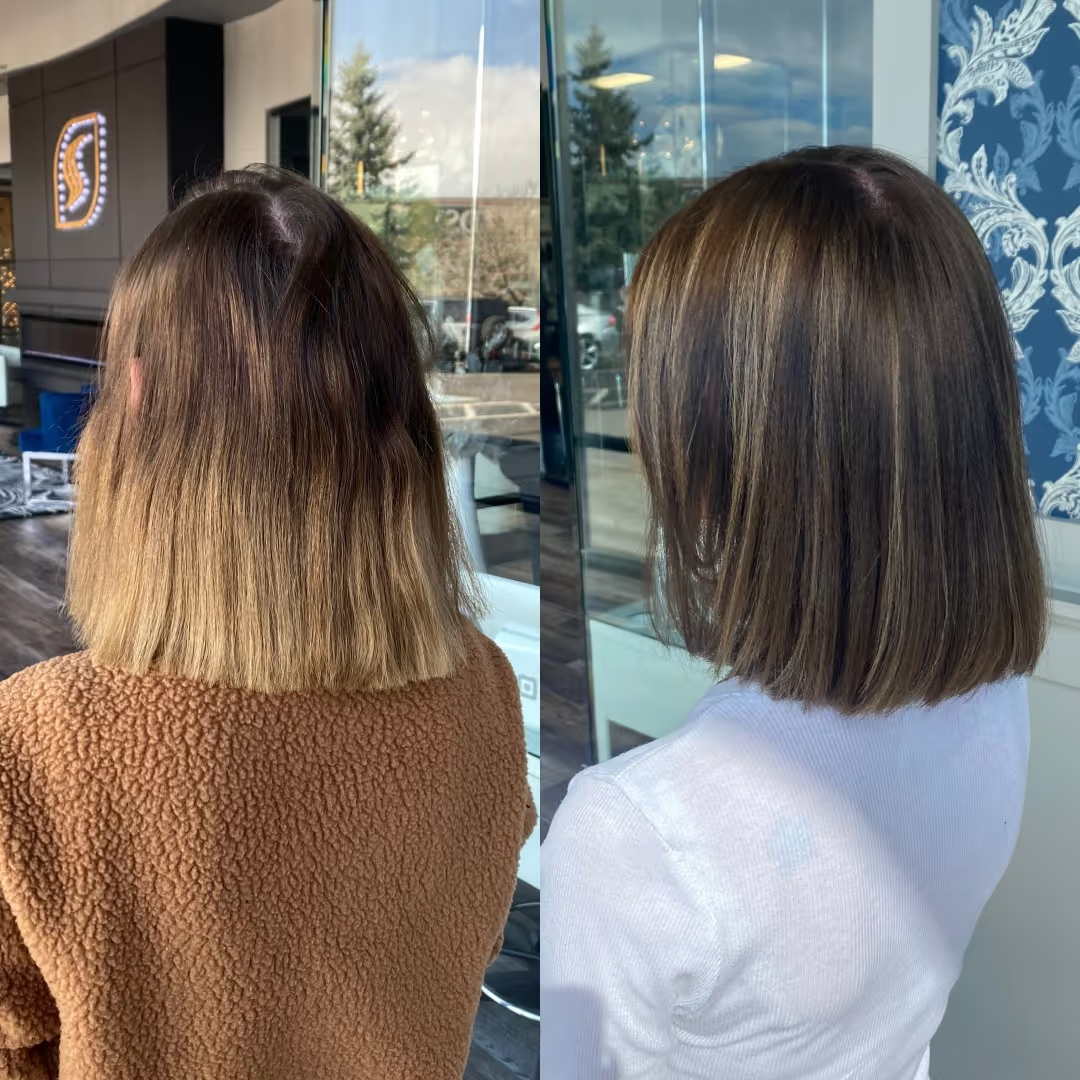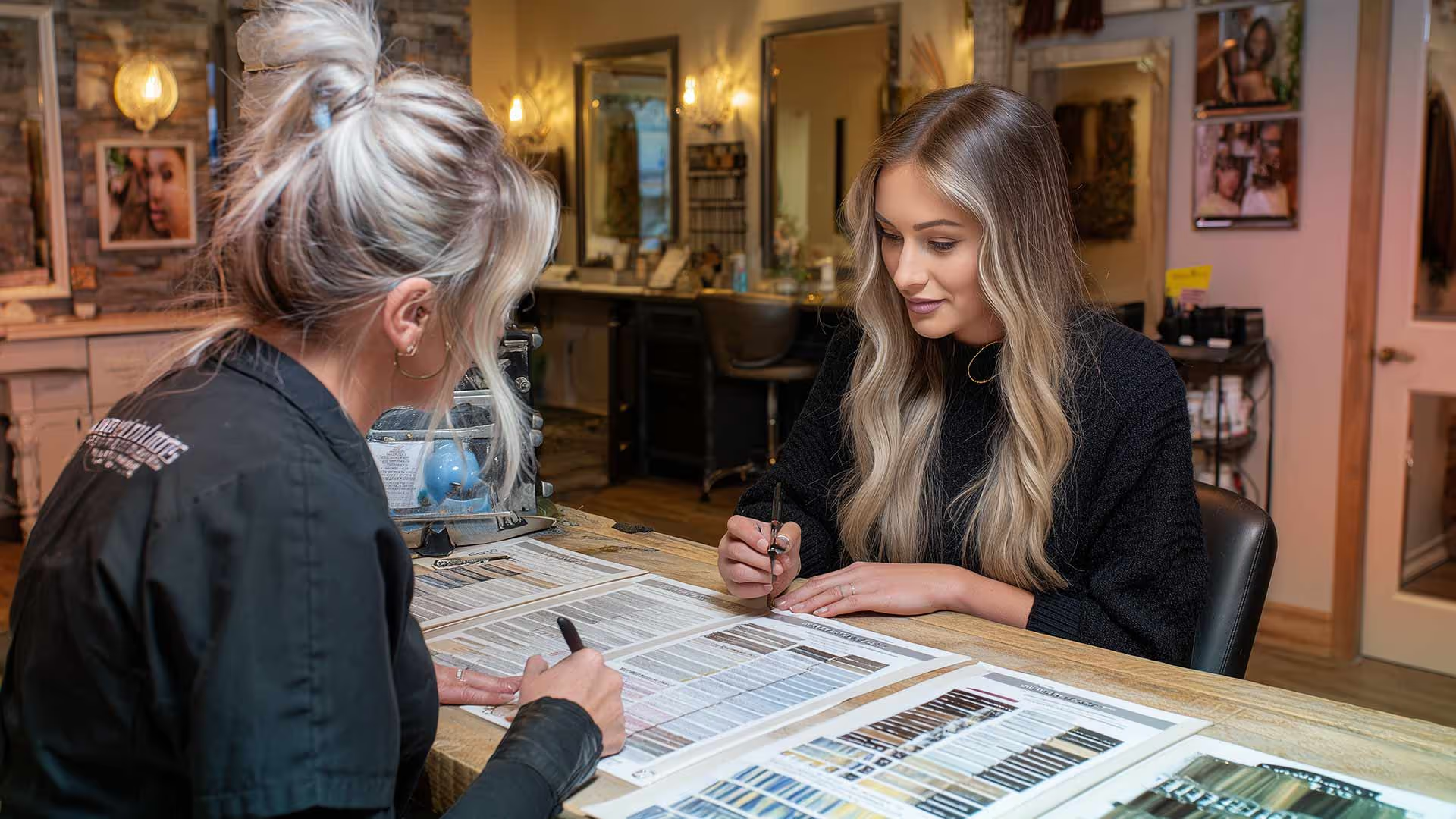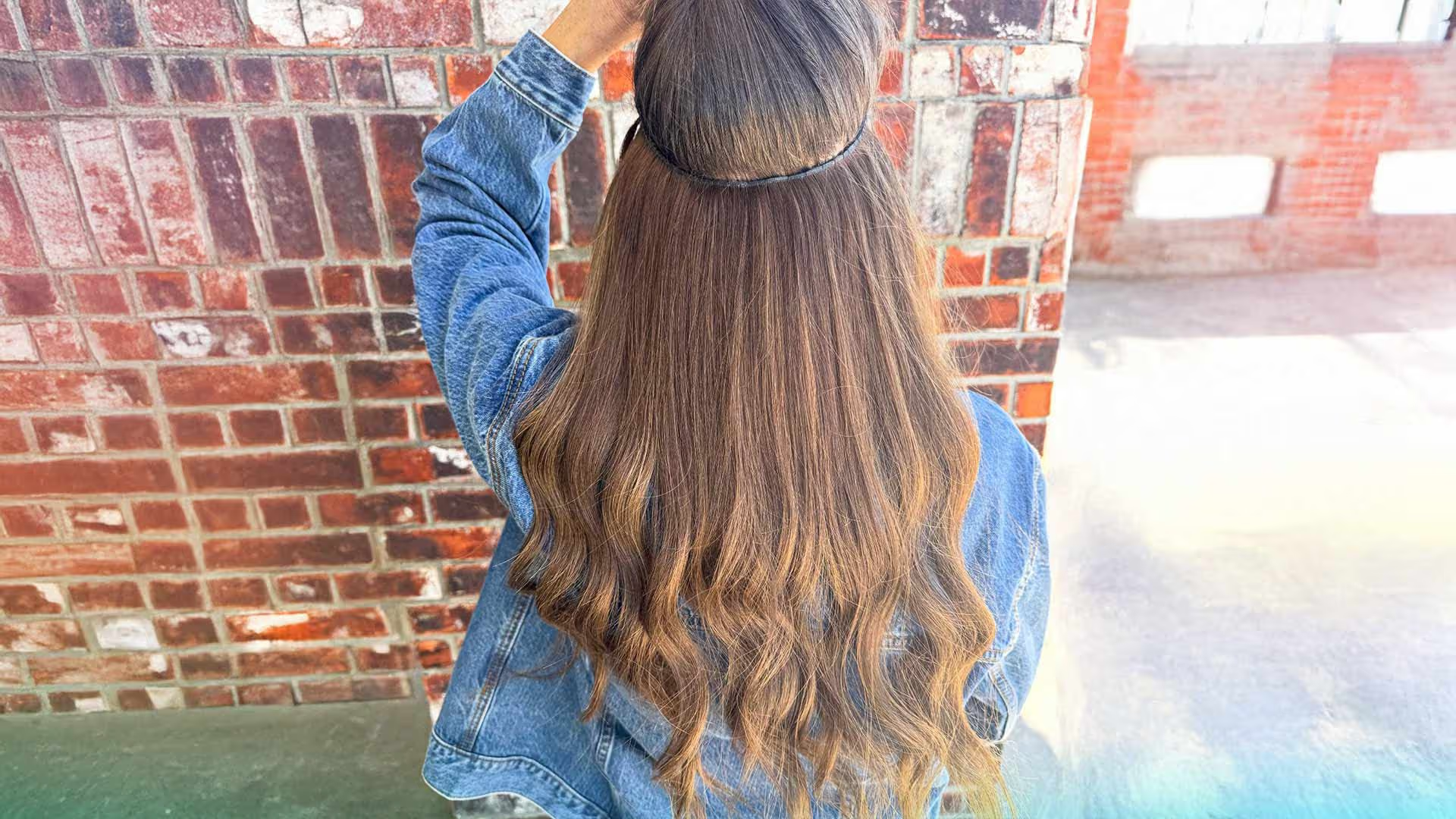When your hair's been through the wringer from chemical processing or heat damage, finding the right extensions can feel overwhelming - but it doesn't have to be a risky gamble with your hair's health.
Key Takeaways
Understanding Your Hair's Damage Level
I see you, and I understand how heartbreaking it can be when your hair doesn't feel like "you" anymore. After years of working with clients whose hair has been through so much, I've learned that the key isn't just finding extensions that look good - it's finding ones that will love your hair back to health while giving you the confidence you deserve!

Your hair's been through chemical processing, heat styling, or maybe both. The cortex (that's the inner layer) is compromised, the cuticles are probably raised and rough, and your strands have lost their natural elasticity. What this means is that your hair can't handle the same weight and tension that healthy hair can manage without consequences.
I've seen too many clients come to me after horror stories - hair that's matted beyond repair, bald spots from extensions pulling too hard, or just overall thinning that made their original problem even worse. The good news? When we choose the right method for your specific damage level, extensions can actually protect and support your hair's recovery journey.
The first step is getting honest about where your hair stands. Light damage might show as some dryness and breakage around the ends. Moderate damage usually includes significant breakage, visible thinning, and hair that feels rough or straw-like. Severe damage means your hair breaks easily when wet, has extensive thinning throughout, or shows visible bald patches.
The Safest Extension Methods for Compromised Hair
Let me tell you about halo extensions - they're honestly a game-changer for damaged hair! The transparent wire sits like a headband around your head, giving you instant volume and length without a single point of attachment to your natural strands. I love these for clients who've had bad extension experiences before because there's literally zero risk of further damage.

Clip-in extensions come in second for safety, and they're what I recommend most often for my damaged-hair clients. The key is strategic placement - we avoid the most compromised areas and use fewer pieces to distribute weight properly. I always tell my clients to limit wear to 3-4 days weekly maximum when dealing with severe damage, but for moderate damage, they can be worn more frequently.
For mild to moderate damage, tape-in extensions can work when applied by a certified professional. The medical-grade adhesive distributes weight evenly across a larger surface area, which reduces tension on individual hair follicles. But here's the catch - they require professional removal and move-ups every 6-8 weeks instead of the usual 8-12 weeks for healthy hair.
What should you avoid? Anything that creates point tension. Fusion extensions use heat that can further weaken already compromised strands. Micro-bead methods create the heaviest damage potential because all the weight focuses on tiny sections. Sew-in extensions require tight braiding that puts excessive tension on fragile follicles.
Finding the Right Specialist in Lone Tree
This is where I get really passionate because choosing the wrong stylist can literally ruin your hair recovery journey! You need someone who understands damaged hair specifically, not just someone who "does extensions."
At Jo Hearts Hair, I've been specializing in chemically damaged and fragile hair since 2017. My approach is always hair health first - sometimes that means telling clients they need to wait a few months before we can safely add extensions. I offer free consultations where we'll assess your hair's current condition and create a recovery plan that might include extensions as a supportive element.

What sets my approach apart is that I'm certified with multiple brands - Great Lengths, HairTalk, and CocoMarie - which means I can recommend the safest method for YOUR specific situation, not just push whatever I happen to carry. When a client has moderate to severe damage, I'm usually recommending clip-ins first and foremost.
Other qualified specialists in the area include Glo Extensions Denver, which has 17+ years of experience and specifically mentions working with post-chemotherapy clients. That tells me they understand fragile hair. Becky Houghton Studio in Centennial also offers specialized treatments for chemically damaged hair alongside their extension services.
Red flags to watch for? Any stylist who doesn't ask detailed questions about your hair history, anyone who guarantees that any method will work for damaged hair, or anyone who rushes you into a decision without a thorough consultation.
Protection Strategies That Actually Work
Here's something that might surprise you - professional assessment isn't optional, it's absolutely critical. We need to test your hair's elasticity (how much it stretches before breaking), check the porosity levels (how well it absorbs and retains moisture), and assess follicle condition to determine weight capacity.
The "no pain rule" is non-negotiable. Extensions should never cause headaches, scalp tenderness, or any discomfort. If they do, something's wrong with the application or method choice. I've had clients come to me after tolerating pain from other stylists, thinking it was normal - it's absolutely not!

Strategic placement becomes crucial with damaged hair. We're not just placing extensions where they'll look best - we're placing them where your hair can handle them safely. This often means using fewer pieces, focusing on stronger sections, and sometimes accepting less dramatic results in favor of hair health.
The aftercare routine changes too. Sulfate-free shampoos become mandatory because damaged hair can't handle harsh cleansing agents. Weekly protein treatments help rebuild hair structure (I recommend alternating protein and moisture treatments). Heat protection under 350°F is absolutely essential, and honestly, I tell most of my damaged-hair clients to embrace air-drying as much as possible.
Real Client Stories - The Good and The Cautionary
Let me share some real experiences because they illustrate both what can go right and what can go terribly wrong. I had one client who came to me after a disaster with machine-tied extensions elsewhere. She described "severe matting and excessive damage" with "not much left of my natural hair" after removal. We switched her to properly applied clip-ins, and six months later, her natural hair had recovered significantly.

But I've also seen success stories with the right approach. Another client had over-processed blonde hair that was breaking constantly. We started with a deep conditioning treatment plan and carefully placed clip-ins only on her stronger mid-length sections. After eight months, her hair had recovered enough that we could consider tape-ins for her wedding.
The warning signs are real though. Traction alopecia (hair loss from pulling) can develop quickly with damaged hair. I've seen clients with visible thinning around the crown after inappropriate extension methods. The photos are heartbreaking - areas where hair just doesn't grow back the same way.
The recovery stories give me hope though. One woman who'd lost nearly half her hair from poorly fitted extensions worked with a specialist for over a year. The recovery process involved gentle scalp treatments, strategic hair cutting, and eventually, carefully applied clip-ins for special occasions. She emerged with thick, healthy hair and renewed confidence.
Cost Analysis - Making Smart Financial Decisions
Let's talk numbers because I know budget matters, especially when you're already dealing with hair damage. Clip-in extensions offer the best value for damaged hair - $110-$525 initially with 6-12 month lifespans and zero ongoing maintenance costs. That's often less than what you'd spend on tape-in maintenance in just a few months.

Halo extensions range $350-$650 nationally with minimal upkeep requirements. Yes, it's a bigger upfront investment, but for severely damaged hair, they're often the only safe option for achieving dramatic length and volume.
Semi-permanent methods get expensive quickly, especially for damaged hair. Tape-ins cost $600-$900 initially here in Denver, but damaged hair requires move-ups every 4-6 weeks instead of 8+ weeks for healthy hair. That $175-$185 reapplication fee adds up to $1,200-$1,750 annually - and that's if everything goes perfectly.
Fusion methods? Honestly, I don't recommend them for damaged hair, but if someone insists, they're looking at $650-$1,300+ initially with complete replacement every 3-4 months. That can reach $3,900 annually, and the heat application often makes the original damage worse.
The hidden costs matter too. Damaged hair extension maintenance includes specialized shampoos, deep conditioning treatments, protein treatments, and more frequent salon visits. Budget an extra $50-$100 monthly for proper aftercare products.
Making the Smart Choice for Your Situation
Here's my honest advice after working with hundreds of damaged-hair clients: start with the safest option, even if it's not your dream scenario. I've seen too many people try to skip steps and end up with worse damage than when they started.
For severely damaged hair, begin with halo extensions or carefully applied clip-ins. Focus the first 6-12 months on hair recovery through proper treatments, gentle handling, and protective styling. Many clients find that once their hair starts recovering, they don't even want the more intensive extension methods anymore!

For moderate damage, you might be able to handle tape-ins with the right specialist. But please, please get that professional assessment first. What looks like "moderate" damage to you might be severe damage to your follicles. I've learned to be conservative with these recommendations because I'd rather underpromise and overdeliver than the reverse.
The timeline matters too. Hair recovery isn't instant - we're talking months, not weeks. But I've seen amazing transformations when clients commit to the process. Your extensions should support your hair's health journey, not work against it.
Frequently Asked Questions
**Can I use heat styling with extensions on damaged hair?**
Yes, but with strict limitations! Keep heat tools under 350°F always, use heat protectant every single time, and honestly, I recommend limiting heat styling to 2-3 times per week maximum. Your damaged hair needs recovery time, and constant heat just slows that process down.
**How long should I wait after chemical processing before getting extensions?**
This depends entirely on the type of processing and your hair's reaction. For highlights or color, usually 2-3 weeks minimum. For bleaching or relaxers, I often recommend waiting 6-8 weeks. But here's the thing - it's not really about time, it's about your hair's current condition. Some people can handle extensions sooner, others need longer recovery.
**Will extensions help hide my damaged hair while it grows out?**
Absolutely! That's actually one of my favorite uses for clip-ins - they let you have the length and volume you want while your natural hair recovers underneath. Think of them as protective styling that happens to look gorgeous. Just remember, the extensions aren't fixing the damage, they're giving you confidence while your hair heals.
**What's the difference between human hair and synthetic for damaged hair?**
For damaged hair, human hair extensions are usually the better choice because they're more forgiving and easier to blend naturally. Synthetic extensions can be rougher and might cause more friction against already fragile strands. Plus, human hair moves more naturally, which means less tangling and pulling.
**Can I color my hair while wearing extensions for damage coverage?**
This is tricky territory! Generally, I don't recommend additional chemical processing while your hair is recovering from damage. If you absolutely need color, consider extensions in your desired shade instead of processing your natural hair further. We can often achieve amazing looks with color-matched extensions that give you the change you want without the chemical damage.
**How do I know if my hair is too damaged for any type of extensions?**
If your hair breaks when gently stretched while wet, if you have active scalp irritation or inflammation, or if you're experiencing rapid, ongoing hair loss, extensions might not be appropriate right now. The good news is that with proper treatment, most hair can recover enough to safely handle at least clip-in extensions within 3-6 months.
Ready for Your Perfect Extension Solution?
Remember, everyone's damaged hair journey is unique! What works for one person might need tweaking for another, and that's completely normal.
Want personalized damaged hair extension advice? Stop by Jo Hearts Hair in Lone Tree, and let's create your perfect recovery and enhancement plan together!
Located at: 9227 East Lincoln Ave, Suite #111, Lone Tree, CO 80124
Follow @joheartshair for daily inspiration and behind-the-scenes peeks at stunning transformations that prioritize hair health! ✨
Your hair's been through enough - let's give it the gentle care it deserves,
XOXO,
Jo 💕




